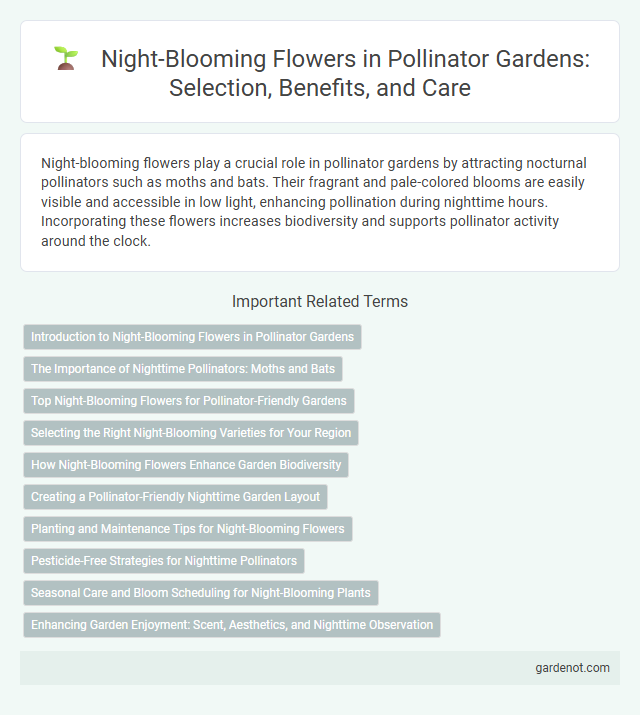Night-blooming flowers play a crucial role in pollinator gardens by attracting nocturnal pollinators such as moths and bats. Their fragrant and pale-colored blooms are easily visible and accessible in low light, enhancing pollination during nighttime hours. Incorporating these flowers increases biodiversity and supports pollinator activity around the clock.
Introduction to Night-Blooming Flowers in Pollinator Gardens
Night-blooming flowers play a crucial role in pollinator gardens by attracting nocturnal pollinators such as moths, bats, and certain beetles, which are essential for ecosystem balance. These flowers emit strong scents and exhibit pale or white colors to maximize visibility and appeal during nighttime hours. Incorporating night-blooming species like evening primrose, moonflower, and night-blooming jasmine enhances biodiversity and supports pollination beyond daylight, promoting a thriving garden environment.
The Importance of Nighttime Pollinators: Moths and Bats
Night-blooming flowers play a crucial role in supporting nighttime pollinators such as moths and bats, which are essential for maintaining biodiversity and ecosystem health. These flowers release strong fragrances and pale colors that attract moths and bats, enabling effective pollination during nighttime hours when diurnal pollinators are inactive. Supporting night-blooming plants in pollinator gardens enhances habitat diversity and ensures continuous pollination services, benefiting fruit and seed production.
Top Night-Blooming Flowers for Pollinator-Friendly Gardens
Top night-blooming flowers such as evening primrose, moonflower, and night-blooming jasmine attract essential nocturnal pollinators like moths and bats, enhancing biodiversity in pollinator-friendly gardens. These fragrant and visually striking flowers release nectar at night, providing vital food sources when daytime blooms are closed. Incorporating night-blooming species into garden designs supports pollinator activity around the clock and promotes a healthier ecosystem.
Selecting the Right Night-Blooming Varieties for Your Region
Selecting the right night-blooming flower varieties for your pollinator garden depends on your regional climate and soil conditions. Native species such as evening primrose (Oenothera biennis) thrive in temperate zones, while moonflower (Ipomoea alba) suits warmer, tropical regions. Prioritizing local night-blooming plants enhances habitat support for nocturnal pollinators like moths and bats, ensuring ecological balance and garden vitality.
How Night-Blooming Flowers Enhance Garden Biodiversity
Night-blooming flowers attract nocturnal pollinators such as moths, bats, and certain beetle species, significantly enhancing garden biodiversity by supporting these specialized creatures. Their unique nectar and scent profiles provide essential resources during nighttime hours when most diurnal flowers are closed. Incorporating night-blooming plants like evening primrose, moonflower, and night-blooming jasmine diversifies pollinator populations and strengthens ecosystem resilience.
Creating a Pollinator-Friendly Nighttime Garden Layout
Incorporate night-blooming flowers such as evening primrose, moonflower, and night-scented stock to attract nocturnal pollinators like moths and bats. Position these plants strategically near garden paths and water sources to maximize accessibility for nighttime visitors. Use low-level lighting and reflective surfaces to enhance visibility without disrupting pollinator behavior.
Planting and Maintenance Tips for Night-Blooming Flowers
Choose night-blooming flowers such as evening primrose, moonflower, and night-blooming jasmine to attract nocturnal pollinators like moths and bats. Plant these flowers in areas that receive partial to full sunlight during the day, ensuring well-drained soil enriched with organic compost for optimal growth. Regular watering during dry spells and pruning spent blooms encourages continuous flowering and maintains plant health in your pollinator garden.
Pesticide-Free Strategies for Nighttime Pollinators
Night-blooming flowers like evening primrose and moonflower attract important nighttime pollinators such as moths and bats, which are highly sensitive to pesticides. Implementing pesticide-free strategies in pollinator gardens preserves these beneficial species by avoiding harmful chemical residues that disrupt their feeding and navigation behaviors. Using organic mulches, companion planting with insect-repellent herbs, and encouraging natural predators supports a healthy ecosystem for nocturnal pollinators while enhancing flower pollination efficiency.
Seasonal Care and Bloom Scheduling for Night-Blooming Plants
Night-blooming flowers such as evening primrose and moonflower require seasonal care that aligns with their unique bloom schedules, typically opening at dusk and thriving in warm, late-summer conditions. Applying organic mulch and consistent watering during dry periods ensures optimal soil moisture for these plants to support night-time pollinators like moths and bats. Pruning spent blooms in early fall encourages a prolonged flowering period and helps maintain plant health throughout the growing season.
Enhancing Garden Enjoyment: Scent, Aesthetics, and Nighttime Observation
Night-blooming flowers enrich pollinator gardens by releasing captivating fragrances that attract nocturnal pollinators such as moths and bats, enhancing nighttime sensory experiences. Their luminous petals and unique forms create striking visual appeal under moonlight, elevating garden aesthetics after dark. Observing these flowers during their peak blooming hours offers gardeners a rare opportunity to engage with the garden ecosystem beyond daylight, fostering deeper connections with nocturnal wildlife.
Night-blooming flower Infographic

 gardenot.com
gardenot.com